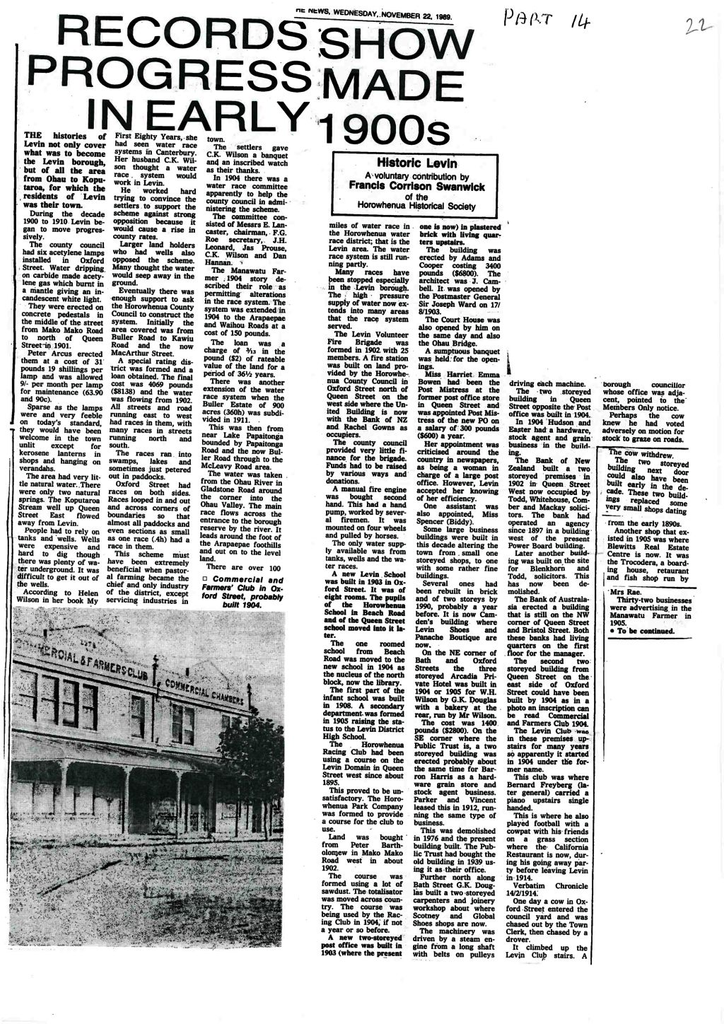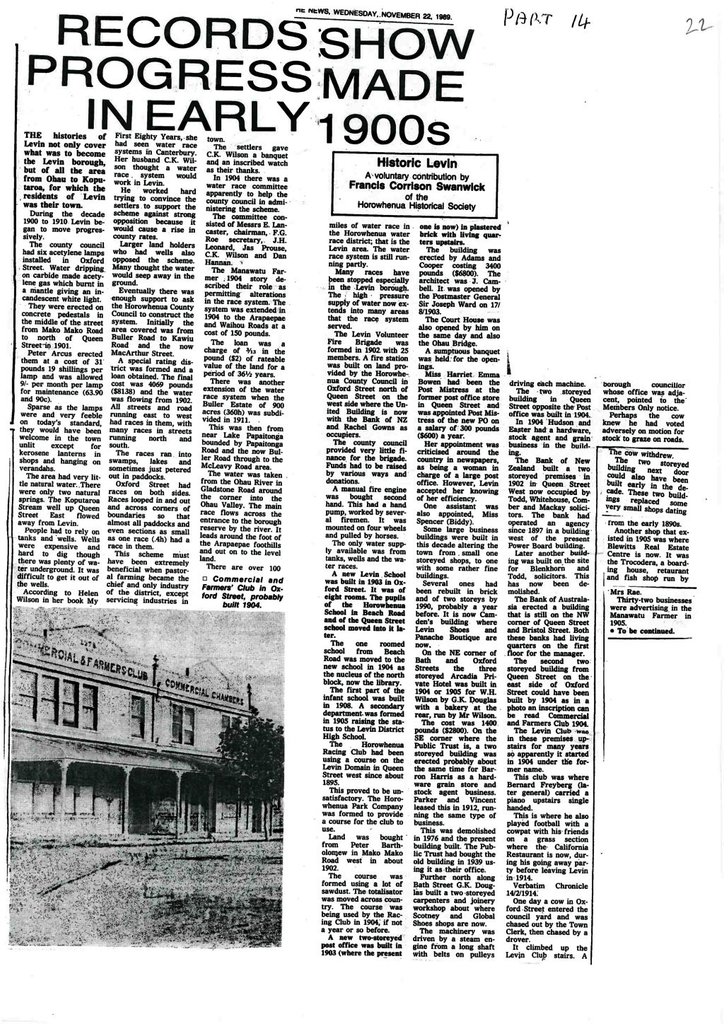Records show progress made in early 1900s
- Description
This text that follows is the content of the attached PDF.
The histories of Levin not only cover what was to become the Levin borough, but all of the area from Ohau to Koputaroa, for which the residents of Levin was their town.
During the decade 1900 to 1910 Levin began to move progressively.
The county council had six acetylene lamps installed in Oxford Street. Water dripping on carbide made acetylene gas which burnt in a mantle giving an incandescent white light. They were erected on concrete pedestals in the middle of the street from Mako Mako Road to north of Queen Street in 1901. Peter Arcus erected them at a cost of £31 19 shillings per lamp and was allowed 9/- per month per lamp for maintenance ($63.90 and 90c). Sparse as the lamps were and very feeble on today’s standard, they would have been welcome in the town unlit except for kerosene lanterns in shops and hanging on verandahs.
The area had very little natural water. There were only two natural springs. The Koputaroa Stream well up Queen Street East flowed away from Levin. People had to rely on tanks and wells. Wells were expensive and hard to dig though there was plenty of water underground. It was difficult to get it out of the wells.
According to Helen Wilson in her book My First Eighty Years, she had seen water race systems in Canterbury. Her husband C.K. Wilson thought a water race system would work in Levin. He worked hard trying to convince the settlers to support the scheme against strong opposition because it would cause a rise in county rates.
Larger land holders who had wells also opposed the scheme. Many thought the water would seep away in the ground. Eventually there was enough support to ask the Horowhenua County Council to construct the system. Initially the area covered was from Buller Road to Kawiu Road and the now Macarthur Street.
A special rating district was formed and a loan obtained. The final cost was £4069 ($8138) and the water was flowing from 1902 on all streets and roads running north and south. The races ran into swamps, lakes and sometimes just petered out in paddocks. Oxford Street had races on both sides. Races looped in and out and across corners of boundaries so that almost all paddocks and even sections as small as one race (.4h) had a race in them.
This scheme must have been extremely beneficial when pastoral farming became the chief and only industry of the district, except servicing industries in town. The settlers gave C.K. Wilson a banquet and an inscribed watch as their thanks.
In 1904 there was a water race committee apparently to help the county council in administering the scheme. The committee consisted of Messrs E. Lancaster, chairman, F.G. Roe secretary, J.H. Leonard, Jas Prouse, C.K. Wilson and Dan Hannan.
The Manawatu Farmer 1904 story described their role as permitting alterations in the race system. The system was extended in 1904 to the Arapaepae and Waihou Roads at a cost of 150 pounds. The loan was a charge of 3/13 in the pound ($2) of rateable value of the land for a period of 36 ½ years.
There was another extension of the water race system when the Buller Estate of 900 acres (360h) was subdivided in 1911. This was then from near Lake Papaitonga bounded by Papaitonga Road and the now Buller Road through to the McLeavy Road area.
The water was taken from the Ohau River in Gladstone Road around the corner into the Ohau Valley. The main race flows across the entrance to the borough reserve by the river. It leads around the foot of the Arapaepae foothills and out on to the level land.
There are over 100 miles of water race in the Horowhenua water race district that is the Levin area. The water race system is still running partly. Many races have been stopped especially in the Levin borough. The high pressure supply of water now extends into many areas that the race system served.
The Levin Volunteer Fire Brigade was formed in 1902 with 25 members. A fire station was built on land provided by the Horowhenua County Council in Oxford Street north of Queen Street on the west side where the United Building is now with the Bank of NZ and Rachel Gowns as occupiers.
The county council provided very little finance for the brigade. Funds had to be raised by various ways and donations. A manual fire engine was bought second hand. This had a hand pump, worked by several firemen. It was mounted on four wheels and pulled by horses. The only water supply available was from tanks, wells and the water races.
A new Levin School was built in 1903 in Oxford Street. It was of eight rooms. The pupils of the Horowhenua School in Beach Road and of the Queen Street school moved into it later. The one roomed school from Beach Road was moved to the new school in 1904 as the nucleus of the north block, now the library. The first part of the infant school was built in 1908. A secondary department was formed in 1905 raising the status to the Levin District High School.
The Horowhenua Racing Club had been using a course on the Levin Domain in Queen Street west since about 1895. This proved to be unsatisfactory. The Horowhenua Park Company was formed to provide a course for the club to use. Land was bought from Peter Bartholomew in Mako Mako Road west in about 1902. The course was formed using a lot of sawdust. The totalisator was moved across country. The course was being used by the Racing Club in 1904, if not a year or so before.
A new two-storied post office was built in 1903 (where the present one is now) in plastered brick with living quarters upstairs. The building was erected by Adams and Cooper costing £3400 ($6800). The architect was J. Cambell. It was opened by the Postmaster General Sir Joseph Ward on 17/8/1903.
The Court House was also opened by him on the same day and also the Ohau Bridge. A sumptuous banquet was held for the openings.
Miss Harriet Emma Bowen had been the Post Mistress at the former post office store in Queen Street and was appointed Post Mistress of the new PO on a salary of £300 ($600) a year. Her appointment was criticised around the country in newspapers, as being a woman in charge of a large post office. However, Levin accepted her knowing of her efficiency. One assistant was also appointed, Miss Spencer (Biddy).
Some large business buildings were built in this decade altering the town from small one storied shops, to one with some rather fine buildings.
Several ones had been rebuilt in brick and of two stories by 1890, probably a year before. It is now Camden’s building where Levin Shoes and Panache Boutique are now.
On the NE corner of Bath and Oxford Streets the three storied Arcadia Private Hotel was built in 1904 or 1905 for W.H. Wilson by G.K. Douglas with a bakery at the rear, run by Mr Wilson. The cost was £1400 ($2800).
On the SE corner where the Public Trust is, a two storied building was erected probably about the same time for Baron Harris as a hardware grain store and stock agent business. Parker and Vincent leased this in 1912, running the same type of business. This was demolished in 1976 and the present building built. The Public Trust had bought the old building in 1939 using it as their office.
Further north along Bath Street G.K. Douglas built a two storied carpenters and joinery workshop about where Scotney and Global Shoes shops are now. The machinery was driven by a steam engine from a long shaft with belts on pulleys driving each machine.
The two storied building in Queen Street opposite the Post office was built in 1904. In 1904 Hudson and Easter had a hardware, stock agent and grain business in the building.
The Bank of New Zealand built a two storied premises in 1902 in Queen Street West now occupied by Todd, Whitehouse, Comber and Mackay solicitors. The bank had operated an agency since 1897 in a building west of the present Power Board building.
Later another building was built on the site for Blenkhorn and Todd, solicitors. This has now been demolished.
 The Bank of Australasia erected a building that is still on the NW corner of Queen Street and Bristol Street (shown on right in photo taken in 1903). Both these banks had living quarters o
The Bank of Australasia erected a building that is still on the NW corner of Queen Street and Bristol Street (shown on right in photo taken in 1903). Both these banks had living quarters o n the first floor for the manager.
n the first floor for the manager. The second two storied building from Queen Street on the east side of Oxford Street could have been built by 1904 as in a photo an inscription can be read Commercial and Farmers Club 1904.
The photo at left shows the Commercial and Farmers' Club in Oxford Street, probably built 1904.
The Levin Club was in these premises upstairs for many years so apparently it started in 1904 under the former name. This club was where Bernard Freyberg (later general) carried a piano upstairs single handed. This is where he also played football with a cowpat with his friends on a grass section where the California Restaurant is now, during his going away party before leaving Levin in 1914.
Verbatim Chronicle 14/2/1914
One day a cow in Oxford Street entered the council yard and was chased out by the Town Clerk, then chased by a drover. It climbed up the Levin Club stairs. A borough councillor whose office was adjacent, pointed to the Members Only notice. Perhaps the cow knew he had voted adversely on the motion for stock to graze on roads. The cow withdrew.
The two storied building next door could also have been built early in the decade. These two buildings replaced some very small shops dating from the early 1890s.
Another shop that existed in 1905 was where Blewitts Real Estate Centre is now. It was the Trocodera, a boarding house, restaurant and fish shop run by Mrs Rae.
Thirty-two businesses were advertising in the Manawatu Farmer in 1905.
Identification
- Date
- November 22, 1989
Taxonomy
- Community Tags


